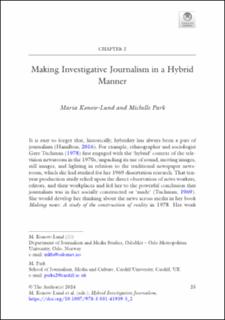Making Investigative Journalism in a Hybrid Manner
| dc.contributor.author | Konow Lund, Maria | |
| dc.contributor.author | Park, Michelle | |
| dc.date.accessioned | 2024-02-01T11:38:13Z | |
| dc.date.available | 2024-02-01T11:38:13Z | |
| dc.date.created | 2024-01-19T17:28:17Z | |
| dc.date.issued | 2023 | |
| dc.identifier.isbn | 978-3-031-41938-6 | |
| dc.identifier.uri | https://hdl.handle.net/11250/3115047 | |
| dc.description.abstract | It is easy to forget that, historically, hybridity has always been a part of journalism (Hamilton, 2016). For example, ethnographer and sociologist Gaye Tuchman (1978) first engaged with the ‘hybrid’ context of the television newsroom in the 1970s, unpacking its use of sound, moving images, still images, and lighting in relation to the traditional newspaper newsroom, which she had studied for her 1969 dissertation research. That ten-year production study relied upon the direct observation of news workers, editors, and their workplaces and led her to the powerful conclusion that journalism was in fact socially constructed or ‘made’ (Tuchman, 1969). She would develop her thinking about the news across media in her book Making news: A study of the construction of reality in 1978. Her work remains a model of scholarly engagement with journalism and its various platforms and practices even today. | en_US |
| dc.language.iso | eng | en_US |
| dc.relation.ispartof | Hybrid Investigative Journalism | |
| dc.rights | Navngivelse 4.0 Internasjonal | * |
| dc.rights.uri | http://creativecommons.org/licenses/by/4.0/deed.no | * |
| dc.title | Making Investigative Journalism in a Hybrid Manner | en_US |
| dc.type | Chapter | en_US |
| dc.description.version | publishedVersion | en_US |
| cristin.ispublished | true | |
| cristin.fulltext | original | |
| cristin.qualitycode | 2 | |
| dc.identifier.cristin | 2230888 | |
| dc.source.pagenumber | 25-38 | en_US |
Tilhørende fil(er)
Denne innførselen finnes i følgende samling(er)
-
Publikasjoner fra Cristin [3205]
-
SAM - Institutt for journalistikk og mediefag [333]
SAM - Department of Journalism and Media Studies

